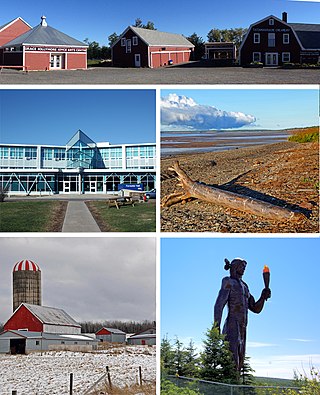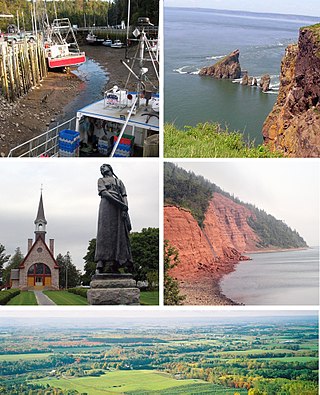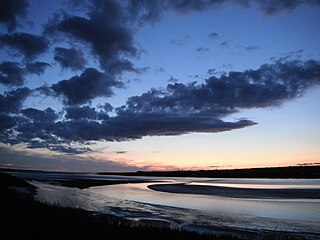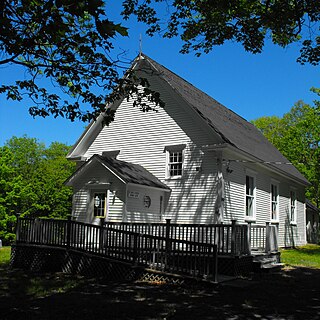Related Research Articles

The Annapolis Valley is a valley and region in the province of Nova Scotia, Canada. It is located in the western part of the Nova Scotia peninsula, formed by a trough between two parallel mountain ranges along the shore of the Bay of Fundy. Statistics Canada defines the Annapolis Valley as an economic region, composed of Annapolis County, Kings County, and Hants County.

Colchester County is a county in the Canadian province of Nova Scotia. With a population of 51,476 the county is the fourth largest in Nova Scotia. Colchester County is located in north central Nova Scotia.

Kings County is a county in the Canadian province of Nova Scotia. With a population of 62,914 in the 2021 Census, Kings County is the third most populous county in the province. It is located in central Nova Scotia on the shore of the Bay of Fundy, with its northeastern part forming the western shore of the Minas Basin.

Truro is a town in central Nova Scotia, Canada. Truro is the shire town of Colchester County and is located on the south side of the Salmon River floodplain, close to the river's mouth at the eastern end of Cobequid Bay.

Kentville is an incorporated town in Nova Scotia. It is the most populous town in the Annapolis Valley. As of 2021, the town's population was 6,630. Its census agglomeration is 26,929.

The Mi'kmaq are a First Nations people of the Northeastern Woodlands, indigenous to the areas of Canada's Atlantic Provinces, primarily Nova Scotia, New Brunswick, and Newfoundland, and the Gaspé Peninsula of Quebec as well as Native Americans in the northeastern region of Maine. The traditional national territory of the Mi'kmaq is named Miꞌkmaꞌki.

Annapolis Royal, formerly known as Port Royal, is a town located in the western part of Annapolis County, Nova Scotia, Canada.

Glooscap is a legendary figure of the Wabanaki peoples, native peoples located in Vermont, New Hampshire, Maine and Atlantic Canada. The stories were first recorded by Silas Tertius Rand and then by Charles Godfrey Leland in the 19th century.
The Eskasoni Mi'kmaw Nation is a band government of the Mi'kmaq First Nations, located in Unama'ki, Nova Scotia, Canada. As of 2021, Eskasoni has a membership of 4,675. Of this population, 3,973 live on-Reserve, and 667 live off-Reserve.
The Membertou First Nation is a Mi'kmaq First Nation band government in the tribal district of Unama'ki, also known as Cape Breton Island, Nova Scotia. As of 2012, the Mi'kmaq population is 814 on-Reserve, and approximately 481 off-Reserve. It operates a community radio station CJIJ-FM. Currently, Membertou has become the most well-off First Nation in Atlantic Canada.

Bear River First Nation is a Míkmaq First Nations band government located in both Annapolis County and Digby County, Nova Scotia. As of 2023, the Mi'kmaq population is 118 on-Reserve, and approximately 263 off-Reserve for a total population of 382.

Glooscap First Nation is a Canadian Mi'kmaq aboriginal community located in both Kings County and Hants County, Nova Scotia. Also known as Kluskap, its reserve is located approximately 6.4 kilometres (4.0 mi) from the Town of Hantsport. Created in 1907 as Horton 35, the reserve encompasses some 171.1 hectares of rolling, mainly forested land. Forest management is practiced by the band. There is a variety store, gas bar, Greco Pizza, and gaming centre. There is also a health centre, youth centre and chapel. The Glooscap Landing Business Park is also owned by Glooscap First Nation which houses a second gas bar and Tim Hortons. The 2023 population was 424 people of whom approximately 100 lived on the reserve, making Glooscap the third-smallest First Nation community in Nova Scotia after Bear River First Nation and Annapolis Valley First Nation. Glooscap's population grew by 41% in one decade between 2013 and 2023.
The Acadia First Nation is composed of five Mi'kmaq First Nation reserves located in southwestern Nova Scotia. As of 2015, the Mi'kmaq population is 223 on-reserve, and 1,288 off-reserve. Acadia First Nation was founded in 1967 and covers the south shore area of Nova Scotia and Yarmouth County. The community runs multiple businesses including five gaming centres, three gas stations and two Rose Purdy centers.
Glooscap 35 is a Mi'kmaq reserve located in Kings County, Nova Scotia.

The Sipekne'katik First Nation is composed of four Mi'kmaq First Nation reserves located in central Nova Scotia. As of 2012, the Mi'kmaq population is 1,195 on-Reserve, and approximately 1,190 off-Reserve. The First Nation includes Indian Brook 14, Nova Scotia, near Shubenacadie, Nova Scotia. The band was known as the Shubenacadie First Nation until 2014 when the traditional spelling and pronunciation of its name was officially adopted.
Paqtnkek Mi’kmaw Nation is a Mi'kmaq Band in northeastern Nova Scotia. Its populated reserve is Paqtnkek-Niktuek 23. As of December 2019 the total registered population was 598. It is a member of the Confederacy of Mainland Mi'kmaq. The name Paqtnkek means “by the bay” or "Above the water ". The area has long been important to Mi'kmaq for the fishing of eel and other species.

Waycobah First Nation is composed of two Mi'kmaq Indigenous communities on Cape Breton Island, Nova Scotia. As of 2012, the population is 833 on-Reserve, and about 82 off-Reserve. It is composed of two parts:

Gabriel Sylliboy was the first Mi'kmaq elected as Grand Chief (1919) and the first to fight for the recognition by the state of Canada of the treaties between the government and the First Nations people.

The following outline is provided as an overview of and topical guide to Nova Scotia:
The Confederacy of Mainland Mi'kmaq is a Tribal Council in Nova Scotia, Canada. It was incorporated in 1986 and has its main office at Millbrook First Nation. It delivers community programs and advisory services to its members. It has eight member communities: Annapolis Valley, Bear River, Glooscap, Millbrook, Paq'tnkek, Pictou Landing, Sipekne'katik, and Acadia, the last of which joined in 2019.
References
- ↑ "First Nation Profiles". Crown–Indigenous Relations and Northern Affairs Canada . Government of Canada. August 6, 2023.
- ↑ "Annapolis Valley First Nation Enterprises".
- ↑ "Glooscap | Mi'kmaq Rights Initiative". mikmaqrights.com. Archived from the original on 2016-05-01.